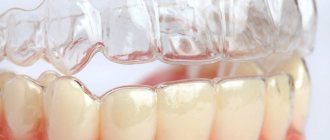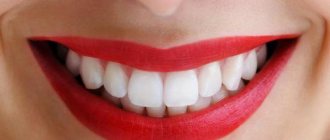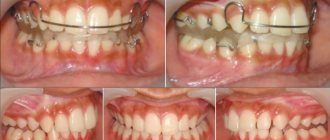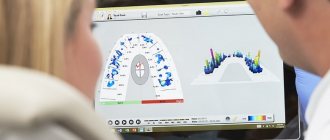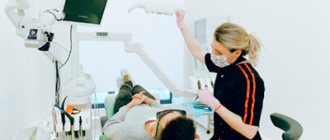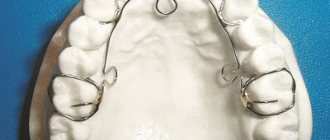Incorrect position of teeth, displacement of occlusal closure, incorrect bite - all these dental problems are solved by orthodontic treatment, which uses corrective devices of various modifications. In situations where the defects are expressed to a small or moderate degree, dentists suggest installing aligners instead of braces - elastic linings that have a similar effect, but do not cause inconvenience to patients. Today, there are many brands on the market, both Russian and foreign, so when choosing the best aligners, you can focus on different comparative criteria.
What are aligners
Aligners for straightening teeth are removable corrective systems that involve consistent micro-movement of teeth into the correct position. Before starting treatment, the patient undergoes a comprehensive diagnosis necessary to create an accurate treatment program. The doctor then takes digital impressions of the teeth and sends them to a laboratory to create corrective aligners. They are made taking into account the natural biomechanics of teeth and jaw movement. The patient receives a set of 10-40 aligners (depending on the clinical picture). The aligners in the set differ in the shape and size of the dental arch. The patient alternates designs until the desired result is achieved.
Elastic, transparent orthodontic aligners made of thin thermoplastic material fit tightly to the teeth, making orthodontic treatment as comfortable as possible for the patient and invisible to others. Even sapphire braces are inferior to aligning aligners in terms of invisibility, aesthetics and wearing comfort.
Aligners are manufactured in more than a dozen laboratories around the world, which gives the patient the opportunity to choose an aligner system at the most attractive price. Teeth straightening at the Ilatan clinic in Moscow is carried out using corrective systems from reliable manufacturers. The use of digital technologies allows you to see your future smile even before correction begins.
Manufacturers of teeth straightening aligners
Which aligners are the best? Today, orthodontists can offer patients several options for mouthguards from different manufacturers. Let's take a closer look at the pros and cons of aligners from the most popular brands.
- Invisalign
In 1998, the American company Align Technology released clear aligners under the Invisalign brand. They were the first to appear in Russia. Today, Invisalign aligners are manufactured at Align Technology factories and are used to treat malocclusions of varying degrees of complexity. A set of aligners from the manufacturer's factory is delivered to the clinic on average within 14 days from the date the doctor confirms the treatment plan. - Star Smile
Aligners are manufactured in Russia at the company's production center. Production time - 10 days. - OrthoSnap
Following Invisalign, OrthoSnap aligners appeared on the American market, which from the very beginning of their existence began to be presented as an inexpensive alternative to the well-known brand. Bracket-free dental treatment with OrthoSnap aligners was actually cheaper at first, but had a number of significant disadvantages. The fact is that the structures were made in a regular dental laboratory using plaster models (Invisalign and Star Smile use 3D models). As for indications, there are not many anomalies that can be treated with OrthoSnap.
Comparison table of aligners from different manufacturers
| Brand | Production | Indications | Efficiency |
| Invisalign (USA) | High-tech production under the supervision of dental technicians with special education. | Most abnormalities in the position of teeth and bite. | Predictable results regardless of the duration of treatment. |
| Star Smile (Russia) | Own production center in Russia. | Most abnormalities in the position of teeth and bite. | Predictable results with a 5-year guarantee. |
| OrthoSnap (USA) | Standard production in a dental laboratory. | Crowding, gaps between teeth, lengthening or shortening of teeth; crossbite. | Unpredictable result. |
In addition to the above brands, there are also many other less popular manufacturers on the Russian dental market. Often such mouthguards are passed off as brands familiar to the patient. Therefore, you should choose an orthodontist on the official website of the manufacturer to avoid becoming a victim of deception.
Pros and cons of aligners
| Advantages | Flaws |
| High aesthetics – a transparent mouthguard is invisible on the teeth, so wearing it is not accompanied by psychological discomfort. | Aligners may not solve complex orthodontic problems |
| Easy to care for – the ability to independently remove the structure and carry out hygiene procedures. | The technology is only suitable for a fully formed dental system |
| Hypoallergenic – the systems are made from a new generation biopolymer thermoplastic material that does not cause allergies. | You need to wear aligners at least 22-23 hours a day |
| Lightness and invisibility – invisible to others, do not affect diction. | There are contraindications |
| Wearing comfort – the design does not contain metal elements that can injure the soft tissues of the oral cavity. | The cost of treatment is higher than correction with braces |
| Efficiency – successfully cope with almost any malocclusion. | |
| Predicting the result – digitally created orthodontic aligners fit precisely, making treatment predictable. |
Alternative solutions
What should you do if aligner treatment is not suitable for you for medical or financial reasons? In this case, it is most rational to use a bracket system. These designs cope with almost any malocclusion pathology. Braces consist of clasps that are fixed on the teeth, a power arch and devices for its fastening. This design causes discomfort when wearing and caring, and most importantly, it does not look very aesthetically pleasing. Even the most fashionable braces will not change the fact that everyone will know about your bite treatment. But if there is no other way out, then you should be patient and correct the situation. The result is worth it.
Veneers can also be an alternative to aligners. They will not correct the defect physically, forever, but they will successfully hide it from others. In addition, your teeth will look not only straight, but also white. But if you have already prepared your teeth for veneers, then there is no turning back. It will no longer be possible to remove them without consequences. They will just need to be changed periodically. True, you won’t have to visit the doctor too often.
Aligners are the most modern, aesthetic and effective way to achieve a naturally beautiful smile. The future of dentistry is his.
Indications and contraindications for installation
Orthodontic aligners can cope even with complex bite defects. Systems are also indicated if you need to move individual teeth in a row, secure or improve the results of wearing braces. Main indications for treatment with aligners:
- trema, diastema;
- crowded teeth;
- distal bite
(the lower jaw occupies a posterior position in relation to the upper jaw); - cross bite
– in which the lower jaw overlaps the upper jaw, and not vice versa; - open bite
– the lateral or front teeth do not close together; - protruding teeth
– one of the dental arches is pushed forward; - direct bite
- the maxillary and mandibular dentitions are closed by the cutting edges of the incisors; - predator fangs
- the fangs overlap the upper incisors; - mesial bite
– the lower jaw protrudes forward.
Teeth straightening begins immediately from the moment the mouthguard is applied, and the first result is noticeable within a month. Corrective mouth guards are used to correct the bite in adults and adolescents when baby teeth have been completely replaced with permanent teeth and the dentofacial system has fully formed.
Aligners are not used to straighten teeth if:
- periodontal diseases, due to an increased risk of losing teeth;
- complex complex defects in jaw development;
- lack of teeth in large numbers (more than 4);
- impacted teeth.
Corrective aligners have fewer contraindications than braces. Thin, weakened enamel does not become an obstacle to corrective treatment with aligners. The doctor will conduct remineralization therapy and then begin to correct the bite. In complex clinical cases, if it is impossible to fully correct the bite without a brace system, it is possible to combine treatment with aligners with the use of braces.
Where to start correcting your bite with aligners?
The first step is to go to the clinic and consult with an orthodontist. Only a doctor can say for sure whether correcting your bite with aligners will be effective in your particular case. Before making a final decision on treatment with mouth guards, it is better, if possible, to listen to the opinions of several specialists, whose contacts are often indicated on the websites of mouth guard manufacturers. Typically, these orthodontists have a certificate of completion of training/training confirming their professional skills in using aligners.
What is better - veneers, braces or aligners?
Since veneers are not able to correct bite defects, it is incorrect to compare them with braces or aligners. Thanks to veneering, you can get a flawless smile, correct the shape and size of teeth, hide interdental spaces, enamel defects, and eliminate slight curvature of teeth. The mechanism of operation of braces and aligners when straightening teeth is completely different - the orthopedic system constantly puts pressure on the dentition, taking into account the natural micromobility of the dental units, gradually moving them to a given position.
The speed of treatment with aligners is 30% higher than with braces. There is absolutely no risk of damaging tooth enamel or injuring the mucous membrane when wearing corrective aligners, which cannot be excluded when treated with braces. Also, the advantages of aligners include the absence of allergies, quick installation and the ability to see your future smile before the correction begins. Braces systems cannot boast of this. In some cases, aligners are powerless, but braces are successful. Elastic aligners do not damage the enamel, provide high-quality dental care and are not visible when worn. Orthodontic aligners are inferior to braces due to narrower indications for clinical use and higher cost of treatment.
Manufacturing Features
When planning orthodontic treatment, digital technologies, specialized software and 3D modeling are used to create unique molds based on individual impressions from the patient’s teeth. To take accurate parameters, a digital intraoral scanner is used, the data from which is transferred to a computer. In the laboratory, 3D models are created according to individual parameters, according to which the required number of aligners is made. Numbered boxes with aligners are delivered to the dentist. The orthodontist explains to the patient how to properly install and remove aligners, and issues kits for 1-2 months of correction. Depending on the selected corrective system, production can take from several days to 2-3 weeks (if we are talking about foreign brands such as Invisalign, FlexiLigner, etc.)
How is the cost of aligners calculated?
It is better to calculate the cost of the course in advance in order to make a decision and be able to pay for it.
Some manufacturers offer installment payments. To choose a manufacturer of structures for therapy, you need to take into account several factors: not everyone uses 3D technology to make a prognosis, the material is different and has a different effect on the mucosa.
Technologies for creating a three-dimensional model of teeth with step-by-step bite correction and their improvement are carried out by Invisalign, 3D Smile, Star Smile, Avantis 3D. The doctor, together with the patient, sees a program on the computer that simulates the change in his bite over time under the influence of the aligners.
Each manufacturer offers its own 3D setup; this is included in the price of the aligners, since the program was developed with the participation of experienced dentists. And thanks to the program, it is possible to show effectiveness and efficiency with a high degree of accuracy.
Orthosnap does not have such a program, so patients do not pay for the setup. The onlays are made as follows: impressions are taken from the teeth, plaster models are created, according to which the trays are formed. There is a possibility of inaccurate execution; this requires adjustment. Time is wasted transporting the plaster model to the USA.
Star Smile offers free visualization of the final effect after. This makes it possible to save from 5,000 to 55,000 rubles. Avantis 3D offers its clients free consultation and setup, as well as therapy development.
Before starting therapy, it is better to know in advance approximately how much you can expect in order to make a choice. We recommend consulting with several specialists.
You can take advantage of all the free offers from different clinics to find out which option is best in your case. After considering all the ways to correct crooked teeth, you can make an objective decision.
The full price of therapy differs from different manufacturers for several reasons:
- Country of Origin.
American aligners are more expensive due to transportation, consultations with foreign specialists, the material of the product, and the exchange rate at the time of payment.
- The severity of the pathology.
To achieve the desired therapeutic effect with a mild degree of anomaly, a smaller number of corrective units is needed. This reduces the overall cost of therapy. In the case of a severe defect, the number of parts and visits to the doctor for control increases, which increases the price.
- Brand popularity.
Products from well-known brands with extensive experience are a priori more expensive than those from dental services that have recently appeared on the market.
- 3D setup.
Companies that do not use the 3D setup (Orthosnap) do not include its cost in the total price, which means the final figure will be slightly lower. But the lack of three-dimensional prediction of the result can negatively affect the course of occlusion correction itself. We have to change therapy along the way, make new mouth guards that were not planned earlier, which increases the time frame.
- Product material.
Manufacturers with extensive experience in creating aligners have time-tested quality aligners. The risk of developing allergies and irritation is minimized. In general, the material used is the same, with the exception of minor differences. Its quality is constantly improving.
Stages of treatment
- Diagnostics
– detection of malocclusions, X-ray examinations (CT, TRG), taking digital impressions, photo protocol (for Invisalign systems). Transferring the results obtained to the laboratory, modeling the progress of treatment. - Preparation
– treatment of teeth, gums (according to indications), sanitation of the oral cavity (removal of stone, plaque), replacement of old defective fillings. - Installation
- the orthodontist will install the first aligners, explain how to insert and remove them, issue a treatment kit, and schedule the next visit. You need to visit a doctor for monitoring every 2-3 months. If problems arise, you should consult a doctor immediately. - Completion of treatment
- when the planned result is achieved, the correction of the dentition is considered complete. The doctor selects a retainer to prevent the teeth from moving back to their original position.
Until the desired result is achieved, the system is worn around the clock, every day, and removed only when eating and brushing your teeth. The aligners are replaced every 2-3 weeks, each new device gradually moves the teeth into the desired position. The duration of orthodontic treatment depends on the clinical picture and ranges from six months to two or more years.
